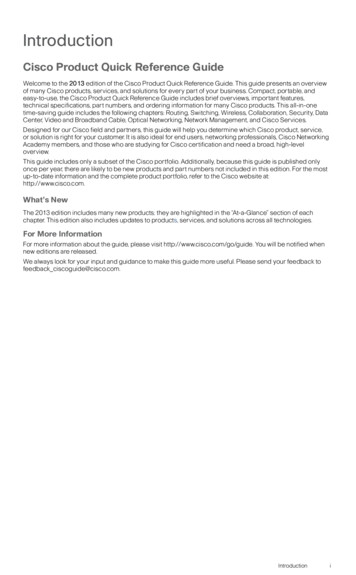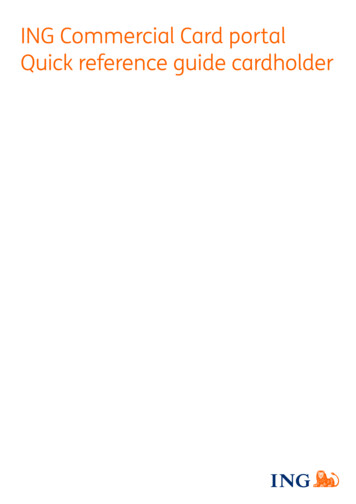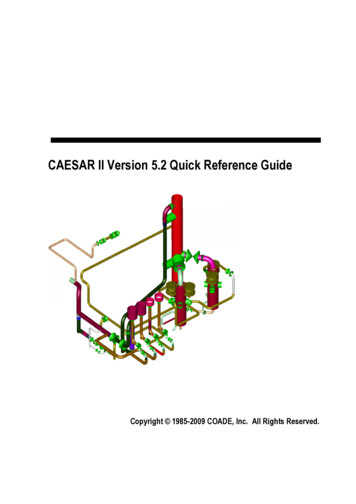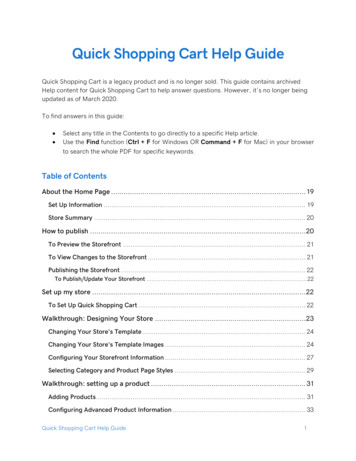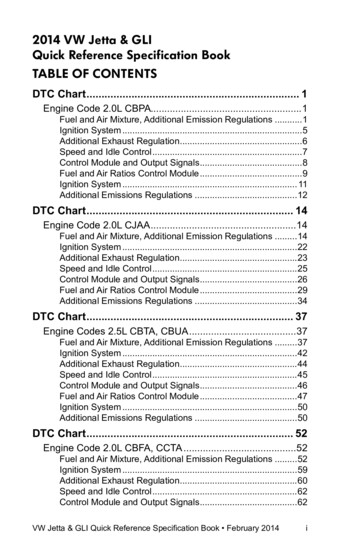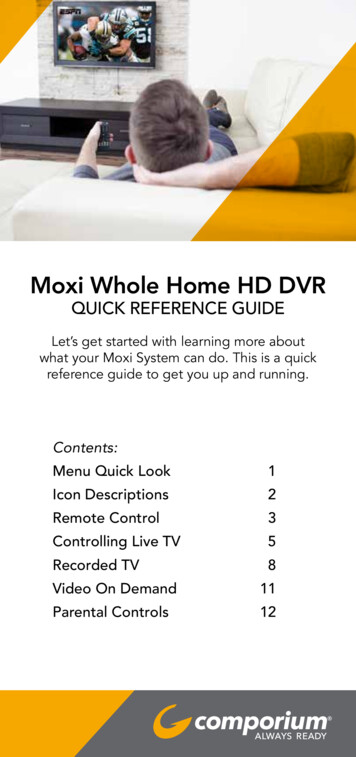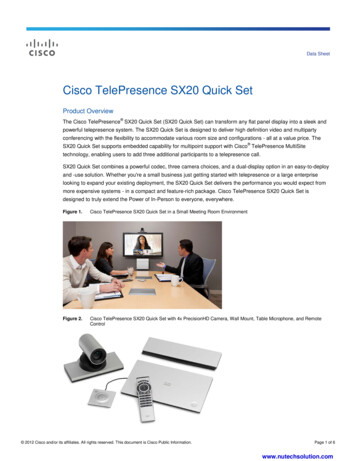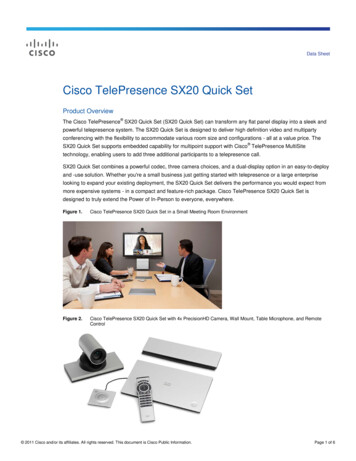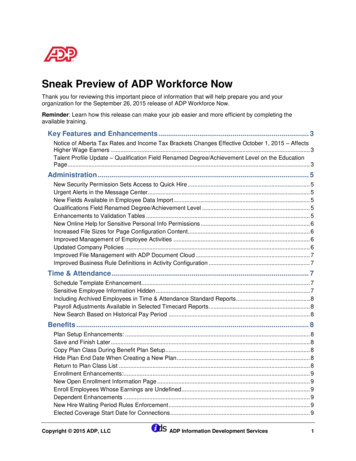
Transcription
FIFTH EDITIONTake theonline quizand getCE credits!A Quick Reference Guideto Credentialing StandardsCarol S. Cairns, CPMSM, CPCS
FIFTH EditionA Quick Reference Guideto Credentialing StandardsCarol S. Cairns, CPMSM, CPCS
Verify and Comply: A Quick Reference Guide to Credentialing Standards, Fifth Edition, is published by HCPro, Inc.Copyright 2009 HCPro, Inc.All rights reserved. Printed in the United States of America.5 4 3 2 1ISBN: 978-1-60146-677-8No part of this publication may be reproduced, in any form or by any means, without prior written consent of HCPro, Inc.,or the Copyright Clearance Center (978/750-8400). Please notify us immediately if you have received an unauthorized copy.HCPro, Inc., provides information resources for the healthcare industry.HCPro, Inc., is not affiliated in any way with The Joint Commission, which owns the JCAHO and Joint Commissiontrademarks.Carol S. Cairns, CPMSM, CPCS, AuthorEmily Berry, EditorErin Callahan, Associate PublisherSusan Darbyshire, Cover DesignerJanell Lukac, Graphic ArtistGenevieve d’Entremont, CopyeditorAdam Carroll, ProofreaderMatt Sharpe, Production SupervisorSusan Darbyshire, Art DirectorJean St. Pierre, Director of OperationsAdvice given is general. Readers should consult professional counsel for specific legal, ethical, orclinical questions. Arrangements can be made for quantity discounts. For more information, contact:HCPro, Inc.P.O. Box 1168Marblehead, MA 01945Telephone: 800/650-6787 or 781/639-1872Fax: 781/639-2982E-mail: customerservice@hcpro.comVisit HCPro at its World Wide Web sites:www.hcpro.com and www.hcmarketplace.com11/200921737
ContentsAbout the Author. .viiAcknowledgments.viiiIntroduction. . ixUNIT 1: Acute Care & Managed CareChapter 1: Initial Appointment/Clinical Privileges/Credentialing.1Practitioners Covered.3Medical Education.6Postgraduate Training (e.g., Internships, Residencies, and Fellowships). .9Board Certification.12Current Licensure.16Sanctions Against Licensure. .17Professional Liability/Malpractice Coverage. .20Malpractice History.22Work History.23Current Competence.25Medicare/Medicaid Sanctions.27Ongoing Monitoring of Sanctions, Complaints, and Adverse Events. .29Federal Drug Enforcement Agency (DEA) Certificate or State ControlledDangerous Substances (CDS) Certificate.32Physical Ability to Perform Clinical Privileges Requested (Health Status). .33Medical Staff Membership.34Clinical Privileges History.36Clinical Privileging System/Initial Granting Of Clinical Privileges.38National Practitioner Data Bank (NPDB).41History of Felony Convictions.42Identity. .44Attestation Statement.45Agreements/Consents/Releases.46Peer Recommendation.47Site Visit.48Temporary Privileges/Provisional Credentialing.50Approval Process/Expedited Approval Process.53Decision Notification.56Hearing/Appeal Process.57Length of Initial Appointment/Credentialing/Clinical Privileges.59Continuing Medical Education (CME).60Time Frame for Completion of Verification/Approval Process.61Verify and Comply, Fifth Edition 2009 HCPro, Inc.iii
ContentsChapter 2: Reappointment/Renewal/Reappraisal of Clinical Privileges/Recredentialing.63Practitioners Covered.65Medical Education.68Postgraduate Training (e.g., Internships, Residencies, and Fellowships). .69Board Certification.70Current Licensure.74Sanctions Against Licensure. .75Professional Liability/Malpractice Coverage. .77Malpractice History.78Work History.79Current Competence/OPPE/Periodic Appraisal.80Medicare/Medicaid Sanctions.83Ongoing Monitoring of Complaints and Adverse Events.85Ongoing Monitoring of Sanctions (Medicare, Medicaid, Licensure).87Federal Drug Enforcement Agency (DEA) Certificate or State ControlledDangerous Substances (CDS) Certificate.90Physical Ability to Perform Clinical Privileges Requested (Health Status). .91Medical Staff Membership.92Clinical Privileges History.94Clinical Privileging System/Reappraisal or Renewal of Clinical Privileges.96National Practitioner Data Bank (NPDB).99History of Felony Convictions.100Identity.102Attestation Statement.103Agreements/Consents/Releases.104Peer Recommendation.105Site Visit.106Temporary Privileges/Provisional Credentialing.108Approval Process/Expedited Approval Process.109Decision Notification.111Hearing/Appeal Process.112Length of Reappointment/Recredentialing/Clinical Privileges.114Continuing Medical Education (CME).115Time Frame for Completion of Verification/Approval Process.116Chapter 3: Other Credentialing Aspects.117Notification to Authorities. .119Nondiscrimination.120Emergency Privileges. .121Disaster Privileges.122Practitioner Termination and Reinstatement.125Date Stamp.126Verbal Phone Verification. .127Fax Verification.128ivVerify and Comply, Fifth Edition 2009 HCPro, Inc.
ContentsInternet/Electronic Verification.129Confidentiality and Protection of Credentialing Information.130Delegation.132Use of CVOs.134Compliance with Local, State, and Federal Regulations. .136UNIT 2: Ambulatory CareChapter 4: Initial Appointment/Clinical Privileges.137Practitioners Covered.139Medical Education.140Postgraduate Training (e.g., Internships, Residencies, and Fellowships).141Board Certification.142Current Licensure.143Sanctions Against Licensure. .144Professional Liability/Malpractice Coverage. .145Malpractice History.146Current Competence.147Medicare/Medicaid Sanctions.148Federal Drug Enforcement Agency (DEA) Certificate or State ControlledDangerous Substances (CDS) Certificate.149Ability to Perform Clinical Privileges Requested (Health Status).150Clinical Privileges.151National Practitioner Data Bank (NPDB).152History of Felony Convictions.153Identity. .154Agreements/Consents/Releases.155Peer Recommendation.156Temporary Privileges.157Approval Process.158Hearing/Appeal Process.159Length of Clinical Privileges.160Continuing Medical Education (CME).161Time Frame for Completion of Verification/Approval Process.162Chapter 5: Reappointment/Renewal of Clinical Privileges. .163Practitioners Covered.165Medical Education.166Postgraduate Training (e.g., Internships, Residencies, and Fellowships).167Board Certification.168Current Licensure.169Sanctions Against Licensure. .170Professional Liability/Malpractice Coverage. .171Malpractice History.172Verify and Comply, Fifth Edition 2009 HCPro, Inc.v
ContentsCurrent Competence.173Medicare/Medicaid Sanctions.174Federal Drug Enforcement Agency (DEA) Certificate or State ControlledDangerous Substances (CDS) Certificate.175Ability to Perform Clinical Privileges Requested (Health Status).176Clinical Privileges.177National Practitioner Data Bank (NPDB).178Agreements/Consents/Releases.179Peer Recommendation.180Temporary Privileges.181Approval Process.182Hearing/Appeal Process.183Length of Reappointment and/or Clinical Privileges.184Continuing Medical Education (CME).185Time Frame for Completion of Verification/Approval Process.186Chapter 6: Other Credentialing Aspects.187Disaster Privileges.189Verbal/Phone Verification.191Fax Verification.192Internet/Electronic Verification.193Delegation.194Use of CVOs.195Orientation of Licensed Independent Practitioners.196AppendixSample Professional Reference Questionnaire.199Online Quiz and Continuing Education Credit Instructions.204viVerify and Comply, Fifth Edition 2009 HCPro, Inc.
About the AuthorCarol S. Cairns, CPMSM, CPCSCarol S. Cairns, CPMSM, CPCS, has participated in the development of the medical staff services profession for morethan 40 years. She is the president of PRO-CON, an Illinois consulting firm specializing in credentialing, privileging, medical staff organization operations, and survey preparation. Cairns is a senior consultant and frequent presenter with TheGreeley Company; she also serves as an information resource for HCPro, Inc. A recognized expert in the field, Cairns isa frequent presenter at healthcare entities as well as state and national seminars.Cairns’ career in medical staff services began in Joliet, IL, where she coordinated and directed medical staff services forProvena Saint Joseph Medical Center and Silver Cross Hospital.In 1991, Cairns became clinical faculty for The Joint Commission by collaboratively developing an educational programentitled Credentialing and Privileging Medical Staff and Allied Health Professionals. She served as clinical faculty for thisprogram from 1991 to 2000. For The Joint Commission, Cairns coauthored The Medical Staff Handbook: A Guide to JointCommission Standards, which focuses on the medical staff credentialing and privileging standards, and authored The LIP’sGuide to Credentials Review and Privileging.In addition, Cairns has been a faculty member with the National Association Medical Staff Services (NAMSS) since 1990.She has presented at numerous state and national seminars on subjects such as basic and advanced credentialing andprivileging, CMS’ Conditions of Participation, The Joint Commission standards and survey preparation, National Committeeon Quality Assurance (NCQA) standards, Healthcare Facilities Accreditation Program Standards, AHP credentialing, coreprivileging, and meeting management and documentation. In 1995, Cairns coauthored the NAMSS educational programfor certification of provider credentialing specialists (CPCS), for which she also currently serves as faculty.In 1996, NCQA appointed Cairns as a surveyor in its certification program for credentials verification organizations (CVO).She surveyed CVOs for the NCQA and was a clinical faculty member for the NCQA on credentialing and CVO certificationuntil 2006. Cairns also serves as an advisor to healthcare attorneys, including providing expert witness testimony regarding credentialing and privileging processes.In 2003, Cairns provided input to the American Osteopathic Association 2004 Healthcare Facilities Accreditation Program,relative to the medical staff and allied health professionals credentialing and privileging standards.In 2005, the Illinois Association Medical Staff Services recognized Cairns by presenting her with the first DistinguishedMember award.HCPro, Inc., books that Cairns has authored include The FPPE Toolbox: Field-Tested Documents for Credentialing,Competency, and Compliance; and Core Privileges for AHPs: A Practical Approach to Developing and Implementing CriteriaBased Privileges.Verify and Comply, Fifth Edition 2009 HCPro, Inc.vii
AcknowledgmentsIn 1968, when I entered the credentialing and privileging world, there were no medical staff offices, medical service professionals, managed care organizations, or provider credentialing specialists. Educational programs for medical staff leaders and credentialing specialists essentially did not exist, and written resources were limited to accreditation or regulatorystandards. Verification of an applicant’s credentials consisted of confirming his or her licensure, graduation from medicalschool, and postgraduate training and obtaining “three personal references.” Often, the applicant hand-carried thesedocuments into the institution and they were accepted without hesitation!What has changed? Nearly everything! Verify and Comply attests to the importance and complexity of credentialing andprivileging processes in today’s world. Patients and plan members depend upon us to do credentialing and privilegingwell. Healthcare organizations (hospitals, managed care organizations, ambulatory care organizations) need for us to docredentialing and privileging well. Accreditors, regulators, and payers expect us to do credentialing and privileging well.The evolution of the art and science of credentialing and privileging has many contributors across the country and overthe decades. Many of us learned our craft from thoughtful leaders. My earliest mentors at (Provena) St. Joseph MedicalCenter in Joliet, IL, were Sister M. Theresa Ettelbrick, administrator, and Leon P. Gardner, MD, medical director. Theywere joined by countless dedicated medical staff leaders (officers, department chairs, committee chairs) and senioradministrators who struggled to “do the right thing” for our patients, the organization, and the medical community.Our quest was also a national quest. Fortunately, we sought and found assistance by networking with other medical staffleaders and medical service professionals across the country. Over the years and through the efforts of many visionaries, we have all created and promulgated industry standards and best practices that focus on protecting the patient.Ultimately, we all share the responsibility of safeguarding and improving the patient care we deliver and receive.It has been an honor and a privilege to learn from, work alongside, and collaborate with some of the healthcare industry’sbrightest stars. I will be forever grateful for the professional and personal experiences and relationships that have evolvedover time and that will last far beyond the life of this edition of Verify and Comply.viiiVerify and Comply, Fifth Edition 2009 HCPro, Inc.
IntroductionThe importance of credentialingOne of the highest-risk procedures performed in a healthcare organization is not performed in an operating room, deliveryroom, GI laboratory, or emergency room. Nor does a surgeon, pediatrician, or family practitioner perform this high-risk procedure.The procedure is credentialing, an activity that is performed in medical staff offices, provider relations departments, andcredentials verification organizations (CVO) across the country. Regardless of the size or type of the organization, credentials specialists, healthcare facilities and physician leadership, managed care organization executives, and governingbodies share the medical and legal responsibilities and accountability to conduct a thorough, comprehensive, and timelycredentialing process. The process includes verification, documentation, and approval of a practitioner’s credentials topractice in a healthcare facility and/or to participate in a managed care plan.Credentialing regulationsThere are federal regulations requiring healthcare organizations to credential and privilege practitioners. The most citedfederal regulations in this regard are the Centers for Medicare & Medicaid Services’ (CMS) Conditions of Participation(CoP). State licensing agencies also
Janell Lukac, Graphic Artist Genevieve d’Entremont, Copyeditor Adam Carroll, Proofreader Matt Sharpe, Production Supervisor Susan Darbyshire, Art Director Jean St. Pierre, Director of Operations Advice given is general. Readers should consult professional co
